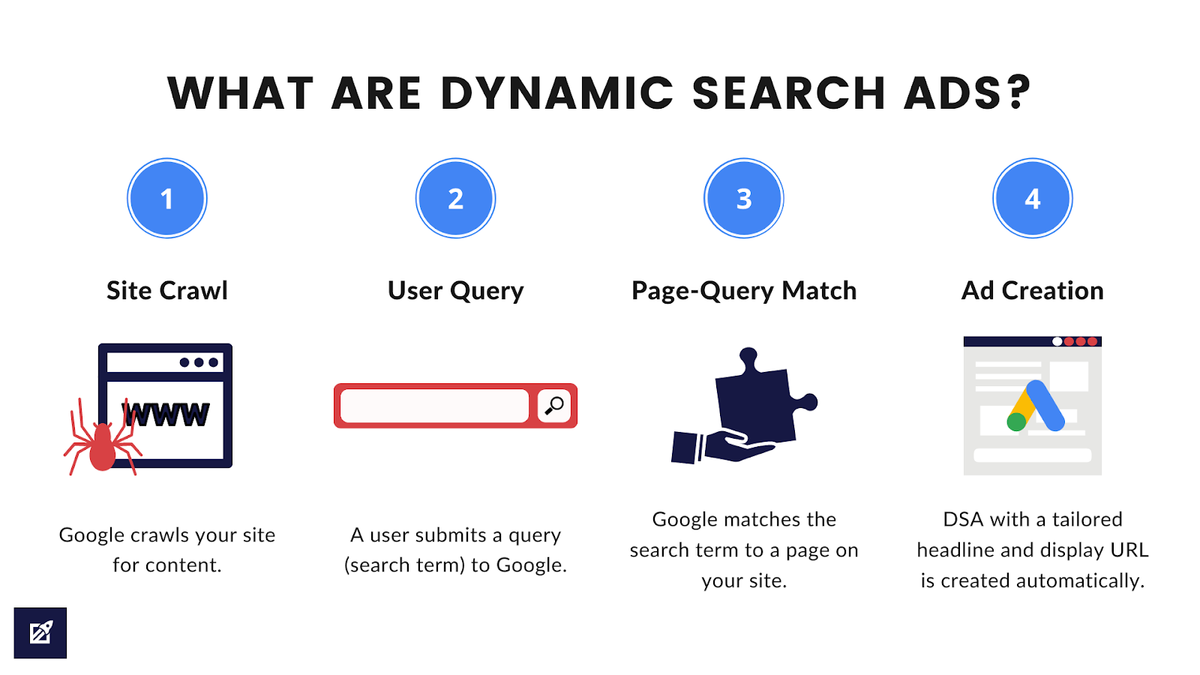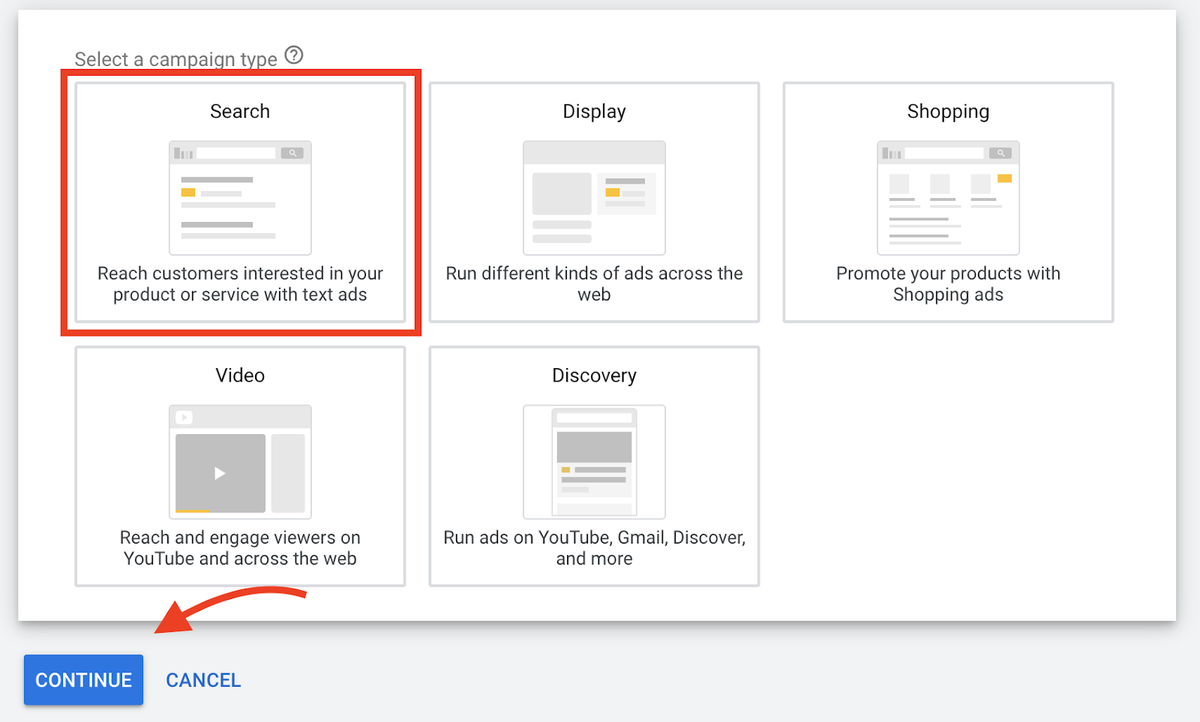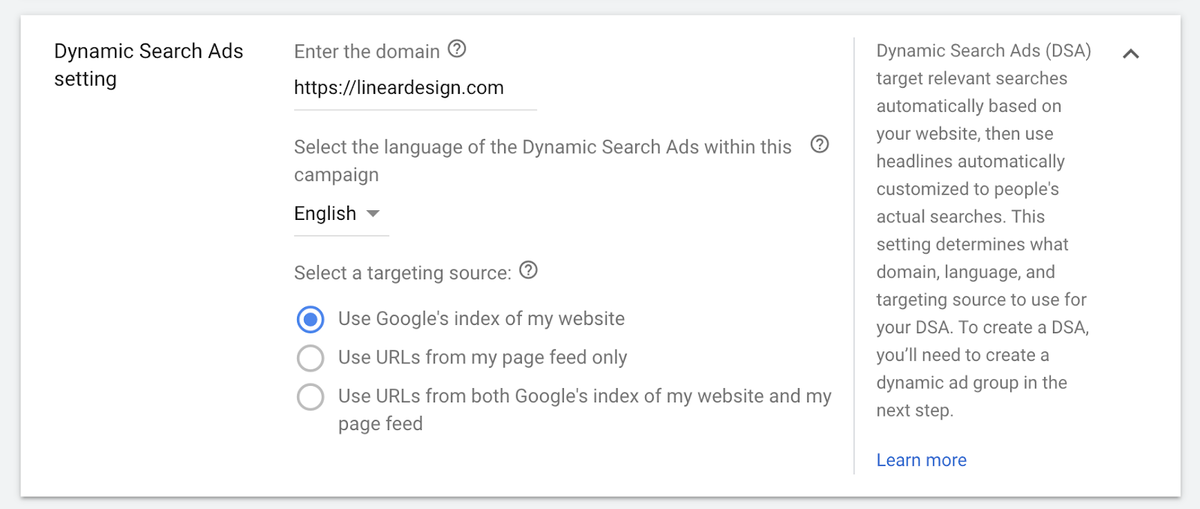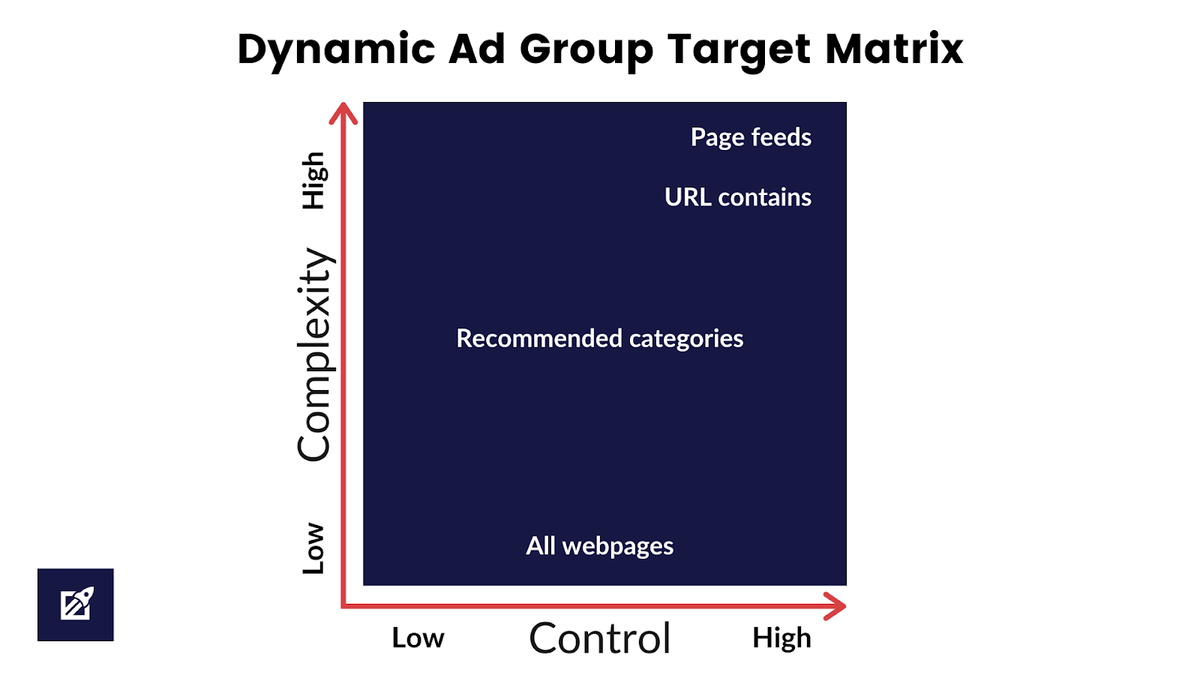Why add Dynamic Search Ads (DSA) to your PPC strategy?
Well, because Google Search isn’t what it used to be.
Or rather, Google users aren’t searching like they used to be.
With more personal devices like mobile (which claimed over 61% of last years’ Google search traffic) and voice, customers are ditching formal in favor of conversational queries–thanks, Alexa.
One result is an increase in unique and unpredictable queries.
Gone are the days where keyword-only Google Ads campaigns can reliably cover the full range of business-related searches.
In other words, the odds increase that advertisers will miss out on valuable traffic to their site.

Eric is tired of lost opportunities. 😤
Google understands that you’re not a mindreader, so they created DSA as an automated catch-all for those outlier searches you’re bound to miss. They’re a quick, scalable, and relatively easy way to check your keyword blindspots and improve keyword-only search campaigns.
So whether you’re a novice or seasoned Google Ads user, we’ve covered everything you need to use DSAs to their full potential.
What are Dynamic Search Ads (DSAs)?
Dynamic Search Ads are automatically filled in and served by Google based on the content on your website.
How do Dynamic Search Ads work?
DSA uses machine learning to identify when landing pages are relevant to a search query; it populates an ad with a relevant headline and display URL based on that information.

To recap how dynamic search ads work:
First, Google indexes your site. It uses that data to decide which search terms relate to the content on your pages.
When a user searches, DSA matches the page it thinks will convert best to that query.
Finally, Google populates the ad with a tailored headline and display URL to serve up in the search results.
The only thing you input manually is the ad description. Easy!
So what’s the catch? Let’s weigh the pros and cons of DSAs.
Pros & Cons of DSA
Every tool comes with pros and cons. Understand the benefits and drawbacks of using DSAs with Google Ads before you jump to setting them up.
Benefits

These DSAs are just *chefs kiss*
There are lots of benefits to DSA; here are a few:
1. Time Savings: Dynamic Search Ads are, well, dynamic. This means Google does a lot of time-sucking tasks like writing headlines for you. Because they use site content to generate ads, you don’t need to worry about keyword management. Additionally, the web crawling tech means you don’t have to manually pause or create ads based on your inventory or seasonal factors.
2. Water-tight keyword coverage: Since ads are created directly from data scraped from your site, you know any queries missed by your keyword campaigns get scooped up by DSAs. Also, your ads will only show when a search is relevant. Plus, available query reports can help you identify new opportunities in your keyword-based search campaigns.
3. Relevance: If you haven’t caught on already, people love a personalized, relevant ad experience. This recent survey found that 90% of consumers say messages from companies that fail to be personally relevant to them are annoying. DSAs help you avoid being annoying; users only see ads whose queries closely relate to your site’s content.
Additionally, Google will match headlines with the most relevant landing page. What do headline-product match and personalized ad copy both do? Increase conversions. We like conversions.
4. Great control for an automated tool: Sure, DSAs are automated, but mostly in the way you want them to be. Although you can’t see into the Google black box for keywords, you can:
- Make changes based on the search query report
- Control bidding at the dynamic target level
- Add negatives to exclude irrelevant traffic or current keywords from another search campaign.
- Choose which landing pages show: the whole website, categories, or just specific pages.
Drawbacks

Avoid pitfalls
Just a couple of things to keep in mind:
1. Keywords are hidden: DSA isn’t like a typical search campaign, which means the keywords Google bids on aren’t available to you. You can see descriptions, ad labels, and search terms for DSA ad groups. You will have to adjust the way you optimize campaigns — but we know you can do it.
2. You can misspend ad budget: if you’re not careful when you choose your bidding strategy (for example, Maximize clicks), it can run your bids way too high. Try Enhanced CPC or Target CPA; the new DSA works quite well with Smart bidding in general. Additionally, sometimes your clicks may be a little low quality, despite being relevant to your site content. It’s essential to monitor your search terms report and costs when your first start out.
When should you use Dynamic Search Ads?
You understand the risks and rewards associated with DSA, but is your business ready to use them?
Dynamic Search Ads may be a perfect fit if you have a well-developed website or have a large inventory. Also, use it as a safety net for keywords you might be missing, not as a stand-alone strategy.
In contrast, reconsider using DSAs if you run rapid (daily) deals. They’re also not great if your business is in the pharmaceutical, gambling, or adult industry or for a website with too many password-protected and single-sign-on pages.
Bonus Tip: In the past, Google Ads managers discouraged using Dynamic search ads unless a business was in travel or retail and had a big website. This isn’t the case anymore. Significant improvements to quality and reach in the last few years mean more businesses benefit from DSAs.
Customize DSA Based on Advertising Goal:
Google recommends you use certain DSA types based on your advertising goal.
Incremental reach: for advertisers who want their ads to show for all relevant searches. Use incremental reach when you want a keyword coverage net. It’s the simplest option, with little implementation and management required.
Long-tail automation: for advertisers who want to show up for Google users even on long-tail product searches. In other words, if you have a large, changeable website, this strategy is for you. Get on long-tail automation if you feel like you miss long-tail traffic with a traditional keyword-only search campaign.
Rapid expansion: for advertisers who want to expand their horizons. Are you blasting into new markets at the speed of light? Rapid expansion is for you, and it’ll assist you in broadening your read beyond your usual geographic or business boundaries.
Before we get into set up, you should be aware of a few key changes to Dynamic Search Ads.
How have Dynamic Search Ads Changed?
You might be familiar with DSA Campaigns — but those are no more. DSAs now run on dynamic ad groups.

How has DSA changed?
New search campaigns include dynamic creatives, dynamic targets, and a standard ad group type with text ads and keywords.
Why the change? Because incremental query coverage was too tricky with divided standard and Dynamic Search campaigns. Like anything that uses machine learning to improve, DSAs need as much data as possible.
Ultimately, including standard and dynamic ad groups in the same campaign helps DSA perform better for more business types.
Enough theory for now. Check out how to set up Dynamic Search Ads.
How to Set Up DSAs
There are three parts to setting up Dynamic Search Ads: creating a new Search campaign and adjusting campaign settings, setting up dynamic ad groups (with dynamic ad group targets), and making Dynamic search ads.
Let’s dig in.
Create a New Search Campaign (Include a Dynamic Search Ad Group)
First, let’s create a new Search campaign in Google Ads.
Navigate to Google Ads; sign in to your account. In Campaigns, clicks the + button or select + New Campaign. Select a Search-compatible objective.

Sales, Leads, and Website traffic all work for Google Ads Search.
Next, choose Search for the campaign type.

From there, enter necessary campaign details, like the campaign name, budget, location targeting, and languages.
For Bidding, you can select automated bidding strategies, but Manual CPC is available as well. For this example, we’ll choose Target CPA.
Finally, under General Settings, click Show more settings, and fill out the Dynamic Search Ads setting.

Essentially, just put your domain, language, and targeting source, which tells Google where to pull data for your ads. The standard is Google’s index of your website, but you can also choose to pull from a page feed.
Save and Continue, and we’ll create a dynamic ad group and targets.
Still confused? No worries. For more information on setting up Google Search campaigns from scratch, check out our Greatest Google Ads Guide.
Set up Dynamic Ad Group Target
This is what you’ll see for your ad group setup. The Dynamic option is the default. Name your ad group!

On this page, you tell Google how it should target your ads. Essentially, you have four main ad target types:
- All webpages – targets your whole website
- Recommended categories – website content is pre-organized into categories based on products or services.
- Page feed – a new option; target a feed of labeled URLs
- Specific webpages (including URL Contains) – target specific webpages that match a URL-string
Each type has varying levels of control and complexity, which we summarize below:

Dynamic ad group target options have variable levels of sophistication and control.
Tip: Google recommends that you use the Landing pages from your standard ad groups category if you’re a beginner. Recommended categories have a middle level of control and complexity.
The standard ad groups category is great because it will use data from the webpages you’re already using with standard search to create DSA ads. It’s most likely to increase traffic to existing pages from current ad groups and campaigns.
Hover over the Previews table to see how the Dynamic ad could appear on Google results.

DSA ad preview
Click Save and Continue.
Fire up Dynamic Search Ads
This step is the easiest. Google lets you create more than one Dynamic Search Ad, so take advantage and test which ones perform best.
Simply click New ad, choose the DSA ad type, enter your description text, and hit Save and Continue.
Remember, the ad headline, final URL, and display URL are all automatic!
Bonus tip: include at least three creatives per ad group. Customize them to fit the landing pages you’re targeting.

So easy. You did it!
Optimizing Dynamic Search Ads
1. Clean up your website
Your website and landing page content is the ultimate source of truth for DSAs. In other words, if your site and landing pages are challenging to navigate or poorly organized, Dynamic Search Ads will run under potential as well.

Give Google’s organic indexing tool some good material to find.
Also, note that Google search ranks DSAs the same way as standard ads. Landing page experience is a crucial part of auction-time ad quality, one of the main ranking factors.
Finally, you can learn more about conversion-friendly landing page design here.
2. Don’t Forget Negatives & Exclusions
Don’t depend entirely on Google to interpret your site content appropriately. Consider adding:
- Negative keywords from lists you use in standard search campaigns
- Irrelevant queries in the Search Terms Report (All campaigns > Auto targets tab > Dynamic ad targets > See search terms drop down)
- Underperforming, expensive, or broad terms or terms with low intent
Additionally, exclude irrelevant and non-commercial parts of your website. This is especially relevant forthe All Website dynamic page target. For example:
- Non-transactional sections: your blog, contact us, thank you page, etc.
- Non-converting pages: expired promotions, error pages, unavailable items, etc.
It’s partially your site quality that improves the likelihood of good DSA interpretations, so again, clean up your landing pages and optimize your website.
Note: Speaking of exclusions, don’t limit yourself too much. The more domain coverage you get by DSA, the better your reach and incremental traffic.
4. Use Automated Bidding
Don’t be the ads manager with an iron grip on Manual CPC! Automated bidding strategies are perfect for DSA because it combines dynamic ads’ benefits with auction-time contextual signals. In other words, it’ll give you a way to gear broad DSA campaigns towards conversions. Plus, if you thought DSA alone was a time-saver, a fully automated campaign will free up even more.

Fast, very fast.
We encourage you to run an experiment using automated bidding and DSAs on a section of your audience to see yourself.
Bonus tip: If you insist on using manual bidding, adjust bids based on how valuable each target is to your business. For example, products that convert well or have an incredibly high ROI. It’s just another level of control over where and when DSAs show up in the search results.
5. Layer existing lists with DSAs
The nice thing about DSA is that it’s designed to enhance, instead of competing with, other Google Ads tools. If you have a standard campaign, DSAs will improve your incremental traffic.
The same is true for layering Dynamic Search Ads with custom audience lists (RLSA, SAS, CM, DFSA).
Just remember: junk in, junk out. So if your site, account, or lists are constructed poorly, DSAs will compound existing issues.
The reverse is also true: if you layer lists with DSAs, they’ll usually improve.
Applying retargeting to a DSA campaign is one way you could immediately improve traffic and recapture lost conversions.
Conclusion
Whew! We covered a lot. To summarize, Dynamic Search Ads are a helpful tool to improve your regular Search campaigns, improve traffic, and cover valuable search terms that escape your keyword list. And since it’s so easy to implement, there’s no reason for you not to give it a try. 😉
Let us know how it goes 👇 in the comments!
Ariana Killpack
Director of Content
Ariana prides herself on always learning everything there is to know about pay-per-click advertising and conversion rate optimization, which is why she can create such excellent content. When she’s not writing fantastic content, you can find her hiking, swimming, or baking bread.
Leave us a comment.
Subscribe to our blog
Subscribe to our blog
Get weekly PPC & CRO advice sent straight to your inbox.
